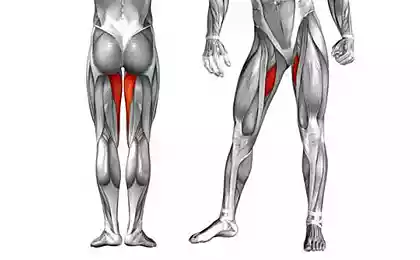667
Eczema is a manifestation of internal problems
Eczema is an inflammatory skin disease, more precisely, its surface layer. Can occur in acute or chronic forms. The nature of this disease is the neuro-allergic, that is an inflammatory process in the body occurs as a result of the action of various stimuli (internal and external). It causes increased activity of immune cells. In appearance, it is expressed in areas of the skin with peeling, redness, cracking and swelling. Sometimes the skin in such areas can be very dry and also form of weeping wounds. It is very easy in these lesions become infected, and therefore accompanied with blackheads and pustules.
Thus, the disease may manifest itself quite differently. However, in the early XIX century it was allocated in a separate category by name. A characteristic feature of eczema is necessary to have a large number of bubbles that appear on the skin, over time they merge into a large group and reveal. It is this process, when they are opened, became the founder of the name of the disease. It was compared with the formation of bubbles in boiling water, and in Greek language", akteo" means to boil. So there was a name for this disease. After bubbles reveal, in their place by a kind of serous depressions ("wells"). Then they turn into weeping wounds or inflamed skin peel. Severe itching throughout all stages of the disease development is a characteristic of eczema.
According to medical statistics, about 40% of all skin diseases in eczema. Age when you might be disease is different. So, to get sick and the baby's first months of life, and adult and elderly people. According to statistics, about 2 — 3% of all adults worldwide suffer from this disease. The main cause of the disease is the excessive activity of local immunity, which is caused by frequently occurring in modern people's life factors (stress, negative emotions and experiences). Burden such as different infections (SARS, other infectious diseases), the abundance of allergens in a person's life (home and food). So eczema should not be seen as just a skin disease, and as a signal of significant violations in the work of the whole organism.
When there is eczema, it is often confused with manifestation of allergic dermatitis. Dermatitis, of course, can often be a precursor to developing eczema. But, unlike dermatitis, eczema, there is an acute sensitivity of the skin to various stimuli.
In medical practice there were cases of infection (infection) of the disease. A distinctive feature of eczema is its predisposition at the genetic level, that is, there is transmission of this disease by inheritance.
As a rule, the disease begins with the acute form, then passing into the chronic stage, which is characterized by continuous change of periods of exacerbation and remission.
With respect to this disease in society there are many prejudices. For example, what the medicine is powerless in the face of eczema and the disease – a cross for life. In fact, if the time to go to the doctor and to choose individual treatment, the results will be very effective. But if the disease has moved into the chronic form, the patient neglects the treatment or stubbornly goes to the doctor, to cure eczema will not succeed.
Many believe that sea water and the action of ultraviolet light are a great tool to relieve the acute symptoms of the disease. On the contrary, it is useful to improve the General condition of the organism, and acute and acute course highly undesirable. Very carefully need to consider taking vitamins, as many of them (e.g. b vitamins) can cause an allergic reaction.
Symptoms
This disease is characterized by constantly changing the clinical stage. When is the acute phase manifestation of the disease, the skin swells, there is erythema (redness due to heavy rush of blood to the capillaries due to inflammation) and have small bubbles (vesicles). These bubbles filled with clear liquid. Opening, they open weeping sores and cracks on the skin. In this case the patient suffers from a severe itching. When these vesicles gradually dry up, in their place are formed crust. Redness does not go away, the skin all the time looks very inflamed. Peel off, and long enough, the skin continues to peel off.
A distinctive feature of eczema is a relapsing the disease, often for many years. For a long time the disease is acute (acute period), then comes the period of remission (temporary weakening or disappearance of characteristic symptoms).
If the disease becomes chronic, there are significant changes in the skin that are permanent. Skin significantly thickens, coarsens, on the affected area and more pronounced skin markings (lines, veins, veins). Thus formed cracks in the skin, deep, painful and poorly healing wounds. Mild itching of the skin constantly bothering the person, and when it is acute, it is almost unbearable.
As manifestations of this disease is the signal of the organism of violations in it, it kind of cry for help, along with these manifestations, there may be a variety of signs. Signs that the body is polluted and needs urgent help. It can be fever, acne on the face and other parts of the body, dandruff, vaginal discharge in women.
The main signals that the disease progresses that need urgently to respond and take measures for treatment are:
Deterioration in General health (fever, frequent headaches, constant fatigue, fatigue, drowsiness, loss of appetite);
The appearance in the vesicles of the rash of pus (they become yellow-green color);
Putrid smell from the opened bubbles.
Causesthe Main causes of eczema:
Genetic predisposition (heredity); Nervous fatigue; Mental trauma (stress, trouble, trouble, a sharp change in external factors); diabetes mellitus (endocrine disease – increase glucose in blood); Hyperthyroidism (increased level of thyroid hormones due to her overly active work); Gastritis (inflammation of gastric mucosa); Colitis (inflammation of the mucous membrane of the colon); Holetsistopankreatit (simultaneous damage to the pancreas and gall bladder); Vegetative-vascular dystonia (complex disease, characterized by a sharp narrowing and widening of blood vessels).
Also, there are a number of factors, which are themselves the cause of the disease are not, but may cause worsening or deterioration. These include:
The most common factor influencing the worsening of the disease, is seasonality. The change of seasons often leads to a clear manifestation of symptoms. Moreover, such influence is individual color. So, in some patients exacerbation occur with the advent of the dry and cold winter, others when it's warm and humid. But, most often, the disease progresses in the autumn and winter season.
In addition, have a negative impact on this process may feature the person's profession. So, employees of chemical plants, steel plants, pharmaceutical and food industries, except that there is a potential risk of Contracting asthma also may develop professional eczema. Painful reaction of the body to intake of harmful substances does not occur immediately, but after a long accumulation of poisons. This disease then is sustainable and difficult to treat.
In children eczema may occur on the background of significant atopic dermatitis (disease of allergic nature). It occurs in 15 – 30% of all cases of children's skin diseases.
The reason of developing this disease never acts alone, eczema is always evolving under the influence of a whole complex of various factors. The greatest role is played by genetic factors and the predisposition to allergic reactions and condition of the human nervous system. Mental state of a person plays a huge role in the development of such diseases. So, stress and nervous shock can cause an initial outbreak of eczema and acute exacerbation of existing disease (nervous and worrying, the person may hard to comb the affected areas to the blood, which causes more inflammation).
Forms of
A unified approach to the classification of the disease does not exist. Considering the disease as a whole, considering the nature of occurrence, the characteristics and peculiarities of its course, it is possible to allocate some forms of:
This (true); Microbial; Seborrheic; Professional; Skin; Children.
The most common form of the disease is real, true or idiopathic eczema. Manifestations of this form of the disease pass following stages: initially formed papules, vesicles or erythema, then comes the period of formation of the crusts or oozing sores, scaly plaques. The final stage is lichenification (thickening and thickening of the skin, education on her rough folds). But not always, these stages occur in this sequence. They can pass the previous stage, go over into each other. Besides, there is only one affected area of the skin can simultaneously be manifestations of different stages of the process.
Some of the features of this eczema:
For this form of the disease characterized by the manifestation of skin symptoms in the rotation, that is, the island is replaced by healthy skin affected. The rash is characterized by symmetry. Along with obvious redness and inflammation on the skin, papules are formed under the stratum corneum of the epidermis, then serous or eczematous wells. They are very itchy, in connection with what is injured and out, formed a moist spot of erosion. There is a pain. These sores gradually dry up, form crusts, and after they left the peeling. In the long course of this form of eczema the skin becomes noticeably thicker, there are deep cracks (especially in areas of tension – on the palms, elbows, knees).
Microbial eczema can be represented in the following forms:
Characteristic features of microbial forms of this disease is the lack of symmetry and definition of the lesions. Thus there is detachment of the skin around wounds (formed by the border of the epidermis). Besides, in this form there are always characterized by cutaneous manifestations occur around wounds, sores and other lesions and inflammation of the skin.
The symptoms of seborrheic eczema always appear on the scalp, in the folds behind the ears, on the face, under the breast, between the shoulder blades. Usually, the disease develops after puberty. The features of this form of the disease are considered to be round or oval scaly spots (pink). Sometimes they are covered with greasy scales yellow. In the skin folds the affected areas become red, they become juicy and moist. Deep creases marked the cracks, sometimes brown. Itching it is very strong.
Professional eczema is directly linked to the influence of harmful factors on the person. Usually, it's the chemicals (salts of Nickel, chromium and cobalt, cement). Most often affects the hands.
When disgidroticheskaya eczema formed vesicles (small bubbles) on the surface of the fingers (from the side). Sometimes found their location on the soles and palms. Vesicles burst and form erosion, or immediately after the vesicles are converted into crust. Unlike dyshidrosis (it is a disease with similar manifestations reminiscent of eczema, and they are often confused), by the end of the process the formation of scabs, can form sharp outlines of inflamed areas.
Clinical symptoms of infant eczema often appear in other forms of the disease (true, microbe, seborrheic), and, in their various combinations. The centers of lesions are the face and head (scalp).
Exacerbation
After passing the acute form, eczema often goes into the category of chronic diseases, and periodically relapse. There are people who have experienced eczema for the first time, changed your lifestyle and safely forgotten about it. But, in a greater number of, still, there are people with chronic form of the disease, which is constantly plagued by aggravation.
What can cause the onset of relapse?
Here are the most common causes of exacerbations:
Food; environment; Household chemicals; Clothing; Change of season; Nervous disorders.
The foods we eat most often cause allergies, and therefore, worsening of eczema. Most affected by this factor are those people who from early childhood, suffer from food intolerances. The most strong allergens, painful reaction that occurs in 90% of allergies are considered to be:
The presence in most foods that are sold in our stores, flavors, preservatives, dyes, stabilizers and other harmful to human body substances, also often leads to the development of allergies. So, if You have a painful reaction in the form of eczema on any product, the disease should begin not with medication, but directly from the exclusion of this product from Your diet. Just a few days or weeks will see improvement.
Symptoms of infant eczema are often triggered by the use of artificial mixtures for feeding of the child. Therefore, young mothers it is so important to establish breastfeeding, and at the same time, to observe a rational diet.
The disease can cause household dust that surrounds a person. Allergies can cause house dust mites, which are often present in carpets, pillows, blankets, soft toys. To combat it, you need to perform a daily wet cleaning, regularly wipe the dust. Don't forget about capital cleaning. The propensity for such an Allergy it is better to refuse from carpets and feather pillows. The air You breathe must be moist, the use of special humidifiers. To help You can also use home purifiers and air ionizers. Exacerbation of eczema may provoke a tick and domestic animals, with whom communication should be limited. The flowering period of plants can also be dangerous for the exacerbation of eczema.
The active use of various chemicals in everyday life very often becomes the cause of exacerbation. Synthetic detergents and cleaning products, air fresheners, cosmetics, hygiene products and even toilet paper can trigger an outbreak. Nowadays, such products contains a large number of dietary supplements and other harmful chemical substances. For example, doctors attributed the strong growth in the number of exacerbations of eczema with the start of production of washing powders with supplements (this was in the early 80-ies). The most common recurrent disease is the damage to the hands (especially in women). This involves using liquid dishwashing soap and. It is not necessary to take baths with the use of foam and gel. In cosmetics should be especially careful, as the components included in its composition, can also provoke an aggravation.
Uncomfortable, poor quality clothes, always in contact with the skin and irritating it may cause aggravation. For example, wool products often contain lanolin and it is a powerful irritant. Best of all, wear clothes, and especially underwear made of natural fabrics (cotton). The fabric should be pleasant to the body and not cause discomfort when wearing. Too tight, pressing and vivaldiana clothing also has a negative impact on the skin. Clothing should be loose, the seams on it must be soft, its edges must not stabbing or cutting the body.
A particularly bad time for eczema patients people is the autumn-winter period. Very often, cold time of the year causes aggravation of the disease. It can provoke colds, cough, runny nose, nasal congestion, skin infections.
And, of course, the most likely source of aggravation is a disorder of the nervous system. Stress at work and at home, sensory overload, anxiety, excitement, depression, anger – all these phenomena are inextricably linked. Therefore, staying in this state, it is impossible to improve the results of treatment of the disease.
P. S. And remember, only by changing their consumption — together we change the world! ©
Join us in Facebook , Vkontakte, Odnoklassniki
Source: www.herbalist.ru/ill36.html
Thus, the disease may manifest itself quite differently. However, in the early XIX century it was allocated in a separate category by name. A characteristic feature of eczema is necessary to have a large number of bubbles that appear on the skin, over time they merge into a large group and reveal. It is this process, when they are opened, became the founder of the name of the disease. It was compared with the formation of bubbles in boiling water, and in Greek language", akteo" means to boil. So there was a name for this disease. After bubbles reveal, in their place by a kind of serous depressions ("wells"). Then they turn into weeping wounds or inflamed skin peel. Severe itching throughout all stages of the disease development is a characteristic of eczema.
According to medical statistics, about 40% of all skin diseases in eczema. Age when you might be disease is different. So, to get sick and the baby's first months of life, and adult and elderly people. According to statistics, about 2 — 3% of all adults worldwide suffer from this disease. The main cause of the disease is the excessive activity of local immunity, which is caused by frequently occurring in modern people's life factors (stress, negative emotions and experiences). Burden such as different infections (SARS, other infectious diseases), the abundance of allergens in a person's life (home and food). So eczema should not be seen as just a skin disease, and as a signal of significant violations in the work of the whole organism.
When there is eczema, it is often confused with manifestation of allergic dermatitis. Dermatitis, of course, can often be a precursor to developing eczema. But, unlike dermatitis, eczema, there is an acute sensitivity of the skin to various stimuli.
In medical practice there were cases of infection (infection) of the disease. A distinctive feature of eczema is its predisposition at the genetic level, that is, there is transmission of this disease by inheritance.
As a rule, the disease begins with the acute form, then passing into the chronic stage, which is characterized by continuous change of periods of exacerbation and remission.
With respect to this disease in society there are many prejudices. For example, what the medicine is powerless in the face of eczema and the disease – a cross for life. In fact, if the time to go to the doctor and to choose individual treatment, the results will be very effective. But if the disease has moved into the chronic form, the patient neglects the treatment or stubbornly goes to the doctor, to cure eczema will not succeed.
Many believe that sea water and the action of ultraviolet light are a great tool to relieve the acute symptoms of the disease. On the contrary, it is useful to improve the General condition of the organism, and acute and acute course highly undesirable. Very carefully need to consider taking vitamins, as many of them (e.g. b vitamins) can cause an allergic reaction.
Symptoms
This disease is characterized by constantly changing the clinical stage. When is the acute phase manifestation of the disease, the skin swells, there is erythema (redness due to heavy rush of blood to the capillaries due to inflammation) and have small bubbles (vesicles). These bubbles filled with clear liquid. Opening, they open weeping sores and cracks on the skin. In this case the patient suffers from a severe itching. When these vesicles gradually dry up, in their place are formed crust. Redness does not go away, the skin all the time looks very inflamed. Peel off, and long enough, the skin continues to peel off.
A distinctive feature of eczema is a relapsing the disease, often for many years. For a long time the disease is acute (acute period), then comes the period of remission (temporary weakening or disappearance of characteristic symptoms).
If the disease becomes chronic, there are significant changes in the skin that are permanent. Skin significantly thickens, coarsens, on the affected area and more pronounced skin markings (lines, veins, veins). Thus formed cracks in the skin, deep, painful and poorly healing wounds. Mild itching of the skin constantly bothering the person, and when it is acute, it is almost unbearable.
As manifestations of this disease is the signal of the organism of violations in it, it kind of cry for help, along with these manifestations, there may be a variety of signs. Signs that the body is polluted and needs urgent help. It can be fever, acne on the face and other parts of the body, dandruff, vaginal discharge in women.
The main signals that the disease progresses that need urgently to respond and take measures for treatment are:
Deterioration in General health (fever, frequent headaches, constant fatigue, fatigue, drowsiness, loss of appetite);
The appearance in the vesicles of the rash of pus (they become yellow-green color);
Putrid smell from the opened bubbles.
Causesthe Main causes of eczema:
Genetic predisposition (heredity); Nervous fatigue; Mental trauma (stress, trouble, trouble, a sharp change in external factors); diabetes mellitus (endocrine disease – increase glucose in blood); Hyperthyroidism (increased level of thyroid hormones due to her overly active work); Gastritis (inflammation of gastric mucosa); Colitis (inflammation of the mucous membrane of the colon); Holetsistopankreatit (simultaneous damage to the pancreas and gall bladder); Vegetative-vascular dystonia (complex disease, characterized by a sharp narrowing and widening of blood vessels).

Also, there are a number of factors, which are themselves the cause of the disease are not, but may cause worsening or deterioration. These include:
- Dryness of the skin (the negative effect of water when bathing);
- The use of cosmetics (soap, shower gel, shampoo) with a pungent odor, poor quality and highly allergenic;
- The use of detergents, cleaners without gloves and other protection of the body from their harmful effects;
- Constant contact with chemicals;
- Constant contact of the skin with coarse, woolen cloth;
- The presence of allergens (house dust mites, pet dander, pollen, trees, products);
- The presence of infection (bacterial, viral, frequent colds, upset stomach, fungi);
- The impact of the environment (abrupt change of climate and temperature, profuse sweating).
The most common factor influencing the worsening of the disease, is seasonality. The change of seasons often leads to a clear manifestation of symptoms. Moreover, such influence is individual color. So, in some patients exacerbation occur with the advent of the dry and cold winter, others when it's warm and humid. But, most often, the disease progresses in the autumn and winter season.
In addition, have a negative impact on this process may feature the person's profession. So, employees of chemical plants, steel plants, pharmaceutical and food industries, except that there is a potential risk of Contracting asthma also may develop professional eczema. Painful reaction of the body to intake of harmful substances does not occur immediately, but after a long accumulation of poisons. This disease then is sustainable and difficult to treat.
In children eczema may occur on the background of significant atopic dermatitis (disease of allergic nature). It occurs in 15 – 30% of all cases of children's skin diseases.
The reason of developing this disease never acts alone, eczema is always evolving under the influence of a whole complex of various factors. The greatest role is played by genetic factors and the predisposition to allergic reactions and condition of the human nervous system. Mental state of a person plays a huge role in the development of such diseases. So, stress and nervous shock can cause an initial outbreak of eczema and acute exacerbation of existing disease (nervous and worrying, the person may hard to comb the affected areas to the blood, which causes more inflammation).
Forms of
A unified approach to the classification of the disease does not exist. Considering the disease as a whole, considering the nature of occurrence, the characteristics and peculiarities of its course, it is possible to allocate some forms of:
This (true); Microbial; Seborrheic; Professional; Skin; Children.
The most common form of the disease is real, true or idiopathic eczema. Manifestations of this form of the disease pass following stages: initially formed papules, vesicles or erythema, then comes the period of formation of the crusts or oozing sores, scaly plaques. The final stage is lichenification (thickening and thickening of the skin, education on her rough folds). But not always, these stages occur in this sequence. They can pass the previous stage, go over into each other. Besides, there is only one affected area of the skin can simultaneously be manifestations of different stages of the process.
Some of the features of this eczema:
- Sudden onset of the disease (for no reason, on healthy skin);
- The formation of small bubbles, the opening and weeping sores;
- Erosion with the formation of serous wells (a kind of hole, wound);
- The lack of clear boundaries painful lesions;
- The visible symmetry of the lesions;
- Itching.
For this form of the disease characterized by the manifestation of skin symptoms in the rotation, that is, the island is replaced by healthy skin affected. The rash is characterized by symmetry. Along with obvious redness and inflammation on the skin, papules are formed under the stratum corneum of the epidermis, then serous or eczematous wells. They are very itchy, in connection with what is injured and out, formed a moist spot of erosion. There is a pain. These sores gradually dry up, form crusts, and after they left the peeling. In the long course of this form of eczema the skin becomes noticeably thicker, there are deep cracks (especially in areas of tension – on the palms, elbows, knees).
Microbial eczema can be represented in the following forms:
- Paratravmaticheskuyu (around burns, wounds and fistulas, last a long time even after healing of these lesions);
- Varicose veins (the result of violations of the microcirculation and sensitivity to microbial flora and drugs that treated varicose veins usually disappear after successful treatment of the underlying disease);
- Numulyarnaya (round and oval lesions of different size (without symmetry), most often on the feet and hands; associated with infection, takes place spontaneously and recurs);
- The nipples and areolas (the result of scabies, skin lesions during breastfeeding, painful allergic reaction to the composition of underwear);
- Mycotic (formed in the foci of fungal infection, is as the destruction of the fungus);
- The external auditory canal (the presence of a fungal infection, purulent discharge with otitis media, increased sensitivity to medications – instillation in the ears);
- Age (the result of increased sensitivity to eye drops, distant Allergy candidiasis);
- Intertriginous (within skin folds – the result of reactions to fungi and purulent inflammation).
Characteristic features of microbial forms of this disease is the lack of symmetry and definition of the lesions. Thus there is detachment of the skin around wounds (formed by the border of the epidermis). Besides, in this form there are always characterized by cutaneous manifestations occur around wounds, sores and other lesions and inflammation of the skin.
The symptoms of seborrheic eczema always appear on the scalp, in the folds behind the ears, on the face, under the breast, between the shoulder blades. Usually, the disease develops after puberty. The features of this form of the disease are considered to be round or oval scaly spots (pink). Sometimes they are covered with greasy scales yellow. In the skin folds the affected areas become red, they become juicy and moist. Deep creases marked the cracks, sometimes brown. Itching it is very strong.
Professional eczema is directly linked to the influence of harmful factors on the person. Usually, it's the chemicals (salts of Nickel, chromium and cobalt, cement). Most often affects the hands.
When disgidroticheskaya eczema formed vesicles (small bubbles) on the surface of the fingers (from the side). Sometimes found their location on the soles and palms. Vesicles burst and form erosion, or immediately after the vesicles are converted into crust. Unlike dyshidrosis (it is a disease with similar manifestations reminiscent of eczema, and they are often confused), by the end of the process the formation of scabs, can form sharp outlines of inflamed areas.
Clinical symptoms of infant eczema often appear in other forms of the disease (true, microbe, seborrheic), and, in their various combinations. The centers of lesions are the face and head (scalp).
Exacerbation
After passing the acute form, eczema often goes into the category of chronic diseases, and periodically relapse. There are people who have experienced eczema for the first time, changed your lifestyle and safely forgotten about it. But, in a greater number of, still, there are people with chronic form of the disease, which is constantly plagued by aggravation.
What can cause the onset of relapse?
Here are the most common causes of exacerbations:
Food; environment; Household chemicals; Clothing; Change of season; Nervous disorders.
The foods we eat most often cause allergies, and therefore, worsening of eczema. Most affected by this factor are those people who from early childhood, suffer from food intolerances. The most strong allergens, painful reaction that occurs in 90% of allergies are considered to be:
- Milk;
- Eggs;
- Honey;
- Citrus fruits;
- Fish;
- Cocoa;
- Nuts.
The presence in most foods that are sold in our stores, flavors, preservatives, dyes, stabilizers and other harmful to human body substances, also often leads to the development of allergies. So, if You have a painful reaction in the form of eczema on any product, the disease should begin not with medication, but directly from the exclusion of this product from Your diet. Just a few days or weeks will see improvement.
Symptoms of infant eczema are often triggered by the use of artificial mixtures for feeding of the child. Therefore, young mothers it is so important to establish breastfeeding, and at the same time, to observe a rational diet.
The disease can cause household dust that surrounds a person. Allergies can cause house dust mites, which are often present in carpets, pillows, blankets, soft toys. To combat it, you need to perform a daily wet cleaning, regularly wipe the dust. Don't forget about capital cleaning. The propensity for such an Allergy it is better to refuse from carpets and feather pillows. The air You breathe must be moist, the use of special humidifiers. To help You can also use home purifiers and air ionizers. Exacerbation of eczema may provoke a tick and domestic animals, with whom communication should be limited. The flowering period of plants can also be dangerous for the exacerbation of eczema.
The active use of various chemicals in everyday life very often becomes the cause of exacerbation. Synthetic detergents and cleaning products, air fresheners, cosmetics, hygiene products and even toilet paper can trigger an outbreak. Nowadays, such products contains a large number of dietary supplements and other harmful chemical substances. For example, doctors attributed the strong growth in the number of exacerbations of eczema with the start of production of washing powders with supplements (this was in the early 80-ies). The most common recurrent disease is the damage to the hands (especially in women). This involves using liquid dishwashing soap and. It is not necessary to take baths with the use of foam and gel. In cosmetics should be especially careful, as the components included in its composition, can also provoke an aggravation.
Uncomfortable, poor quality clothes, always in contact with the skin and irritating it may cause aggravation. For example, wool products often contain lanolin and it is a powerful irritant. Best of all, wear clothes, and especially underwear made of natural fabrics (cotton). The fabric should be pleasant to the body and not cause discomfort when wearing. Too tight, pressing and vivaldiana clothing also has a negative impact on the skin. Clothing should be loose, the seams on it must be soft, its edges must not stabbing or cutting the body.
A particularly bad time for eczema patients people is the autumn-winter period. Very often, cold time of the year causes aggravation of the disease. It can provoke colds, cough, runny nose, nasal congestion, skin infections.
And, of course, the most likely source of aggravation is a disorder of the nervous system. Stress at work and at home, sensory overload, anxiety, excitement, depression, anger – all these phenomena are inextricably linked. Therefore, staying in this state, it is impossible to improve the results of treatment of the disease.
P. S. And remember, only by changing their consumption — together we change the world! ©
Join us in Facebook , Vkontakte, Odnoklassniki
Source: www.herbalist.ru/ill36.html























